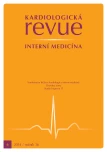Combination immunosuppressant therapy
Authors:
L. Špinarová; J. Vítovec
Authors‘ workplace:
I. interní kardioangiologická klinika LF MU a FN u sv. Anny v Brně
Published in:
Kardiol Rev Int Med 2014, 16(6): 472-474
Category:
Cardiology Review
Overview
In recent years heart transplantation has become an established treatment method for patients with severe heart failure. This treatment involves life-long immunosuppressant therapy with a combination of drugs. Classical immunosuppression is achieved with cyclosporine or tacrolimus, mycophenolate mofetil and corticosteroids. In the last few years, new regimes of immunosuppressive drugs have been used in post-heart transplant patients suffering from renal dysfunction or allograft vasculopathy: a combination of low doses of calcineurin inhibitors with low doses of mTOR inhibitors or calcineurin-free regimes, which are not so nephrotoxic. There has been an effort to withdraw corticosteroids from all regimes after the first year and to have life-long therapy based on a combination of two drugs. Combination therapy is tailored according to the patient’s comorbidities.
Keywords:
immunosuppression – heart transplantation – combination therapy
Sources
1. Costanzo MR, Dipchand A, Starling R et al. The International Society of Heart and Lung Transplantation Guidelines for the care of heart transplant recipients. J Heart Lung Transpl 2010; 29: 914– 956. doi: 10.1016/ j.healun.2010.05.034.
2. Martínek V, Matoušovic K, Špatenka J. Objev a užití cyklosporinu v klinické praxi. Prakt Lék 2002; 82: 14– 20.
3. Rinaldi M, Pellegrini C, Martinelli L et al. FK 506 effectiveness in reducing rejection after heart transplantation: a a prospective randomised study. J Heart Lung Transplant 1997; 16: 1001– 1010.
4. Kurian KC, Addisu A. Sirolimus: a novel immunosupressive drug in heart transplantation. Recent Pat Cardiovasc Drug Discov 2009; 4: 187– 191.
5. Mancini D, Pinney S, Burkhoff D et al. Use of rapamycin slows progression of cardiac transplantation vasculopathy. Circulation 2003; 108: 48– 53.
6. Delgado JF, Manito N, Segovia J et al. The use of proliferation signal inhibitors in the prevention and treatment of allograft vasculopathy in heart transplantation. Transplant Rev 2009; 23: 69– 79. doi: 10.1016/ j.trre.2009.01.002.
7. Špinarová L, Vítovec J. Imunosupresivní léčba po transplantaci srdce. Kardiol Rev 2009; 2: 63– 65.
8. Lund LH, Edwards LB, Kucheryavaya AY et al. The Registry of ISHLT: Thirtieth Official Adult Heart Transplant Report‑ 2013; focus theme: age. J Heart Lung Transplant 2013; 32: 951– 964. doi: 10.1016/ j.healun.2013.08.006.
9. Rothenburger M, Zuckermann A, Bara C et al. Recommendations for the use of everolimus (Certican) in heart transplantation: results from the second German‑ Austrian Certican Conference. J Heart Lung Transplant 2007; 26: 305– 311.
10. Schena FP, Pascoe MD, Alberu J et al. Conversion from calcineurin inhibitors or sirolimus maintenance therapy in renal allograft recipients: 24- month efficacy and safety results from the CONVERT trial. Transplantation 2009; 87: 233– 342. doi: 10.1097/ TP.0b013e3181927a41.
11. Wasywich CA, Croxson MC, van Doomum GJ et al. Sirolimus for Kaposi’s sarcoma. J Heart Lung Transplant 2006; 25: 726– 729.
12. Potena L, Bianchi IG, Magnani G et al. Cyclosporine lowering with everolimus or mycophenolate to preserve renal function in heart recipients: a randomised study. Transplantation 2010; 89: 263– 265. doi: 10.1097/ TP.0b013e3181c42b95.
13. Groetzner J, Kaczmarek I, Muller M et al. Calcineurin‑inhibitor‑free immunosuppression with mycophenolatmofetil and sirolimus after cardiac transplantation is safe and improves renal function significantly: 2 year follow up. Transplantation 2004 ; 78 (Suppl 2): S161.
Labels
Paediatric cardiology Internal medicine Cardiac surgery CardiologyArticle was published in
Cardiology Review

2014 Issue 6
Most read in this issue
- Aortic diseases – diagnosis, classification and management principles
- Combination of anticoagulant and antiaggregant treatment in patients after myocardial infarction with an indication for anticoagulant treatment – so‑ called triple therapy
- Triple-combination in the treatment of hypertension
- When to recommend a combination of ACE-inhibitors and angiotensin receptor blockers
